Combined British and Dutch elements of the Norwegian-led task group heading for demanding Arctic exercises have assembled in southern Norway, say the Royal Navy.
Helicopters, warships and commandos have gathered for Exercise Cold Response in Stavanger, before heading north for the beginning of the biggest UK training in the region for nearly a decade.
In all, 15,000 troops from ten nations are descending on Cold Response to test their ability to work together in one of the most unforgiving environments on earth.
According to a Royal Navy news release, a UK-Netherlands Amphibious Task Group as part of Cold Response is centred around amphibious ships HMS Albion and HNLMS Johan De Witt. From there, raids by Royal Marines and allied forces will be launched onto the Norwegian coastline.
Captain Philip Dennis, who is deployed on Johan Witt as Deputy Commander Amphibious Task Force, said:
“Embarking helicopters, Royal Marines, sailors, soldiers and Air Force personnel supported from NATO allies across two highly capable amphibious warships proves we have the capability to deploy globally in support of our partners and allies, while our ability to operate in extreme conditions proves our resilience and flexibility.
This exercise is also supporting the development of our Future Commando Force capabilities that will harness future innovations and technological developments that have recently become available to take forward on to the battlefield.”



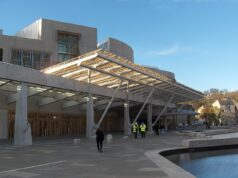
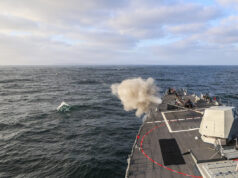
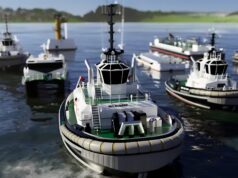
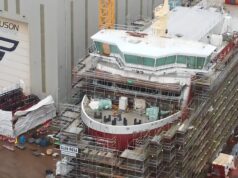
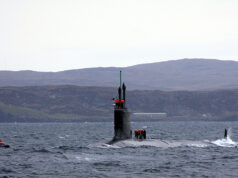
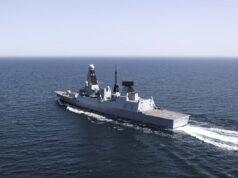

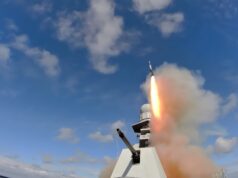
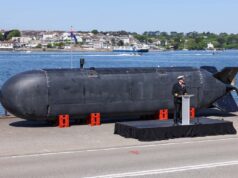
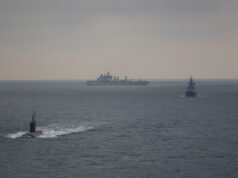

My, that is one impressive vessel…what a flight deck…but where is the hanger?
If you caste your eye directly south of the Vulcan Phalanx CIWS you may spot them. Think car garage roller shutter door types.
Always thought the Albions didn’t have hangers on them, just a large flight deck? The roller shutter doors don’t look big enough for a copter…
There’s no hangar on the Albion class. That shutter door provides vehicular access.
No hangers on the Albion, they had to add pre-fabricated hangers on the Bay class too. Totally bizarre decision to omit them considering how much flexibility they add. Assumption was probably that they would be in a task group with a carrier or ocean so why would they need a hanger.
Actually in the design phase there was an entire extra deck which had hangar space and a ‘welfare facility’ for the embarked force. According to one of the RN officers I spoke to when embarked (in 2009) the RN faced a choice. One all singing all dancing vessel, or two slightly downgraded vessels. Given the aspiration at the time was to ‘be able to put a Bde on the shore by 2025, the choice seems sensible.
The treasury keeps threatening to sell one so maybe they should have gone all singing and dancing. I don’t think they would have needed an extra deck just a larger door and the option to include hanger facilities. It was the same as they bay class, they used a Spanish/Dutch design then spent money removing the hanger only at add a pre fab latter. Completely stupid.
You realise the size of the flight deck when you a Chinook on it.
https://www.google.com/search?q=HMS+Albion&client=firefox-b-d&sxsrf=ALeKk01daD992dZTZK5BswKwMESK2ZfJ0w:1583176784893&tbm=isch&source=iu&ictx=1&fir=vYrw9ldsVAhPGM%253A%252CHHjuK_tjYxlrKM%252C%252Fm%252F028ntg&vet=1&usg=AI4_-kQORV8Nmq6wgTUABEwo45kyVBWPGQ&sa=X&ved=2ahUKEwjC7ISPwfznAhXGYcAKHXH_BjIQ_B0wIHoECAoQAw#imgrc=vYrw9ldsVAhPGM
The roller door is the access to the vehicle ramp that goes down to the vehicle deck. If needs must you can put a Lynx sized aircraft in there.
The flight deck has been remarked out post refits so that it can operate 2 Chinook turning and burning at the same time. The helo starting and servicing electrical system can operate and start any aircraft in the UK inventory including Apache.
You cannot really add a Hangar now without removing a lot of compartments. Stbd side is the emergency Genset and port is the Flight briefing rooms and flight deck teams crew shack.above that is Flyco and a couple of other Compartments that are required for other systems.
Yes a deck was sacrificed so that two ships could be built. A similar thing happened on T45. 5 ships and a full spares package or 6 ships and a minimal spares package. We got 6 ships and then spent a fortune trying to provide spares for the things via CLS.
What is that small boat right at the back of the deck used for ?
It looks like one of the SBS FIC, or fast interceptor craft, although my eyes may be wrong. Daniele can you see it better lol.
Ok cheers.
Lol mate. I cannot even see where I’m meant to be looking! I only see the ships boats.
The SBS FIC are real beauties. Would love to know how many we have and their details. I know we’ve at least 2.
Doubt LPDs would carry them, you want SD Victoria or a visit to Poole Harbour.
You would not believe the stuff you can fit in the vehicle and we’ll deck. If you have a boat but it down stairs. We had something like 6 ORCs at one point taking up a vehicle lane as well as the 4x LCUs in the dock, and 4 x LCVPs on the Derrick. Using the overhead crane on the vehicle deck you can lift anything up and deposit it onto an LCU or directly into the flooded Dock.
Could not even see it mate, was looking on phone!
Now on PC and not the FIC but no idea what it was either until Lusty said.
Got it mate, now looking again bit to stubby for a FIC, cheers Daniele and cheers Lusty
It’s a DSTL Mast-13 vessel. Mast starting for Maritime Autonomy Surface Testbed, 13 meters in length.
Presumably she’s catching a ride on Albion for some more testing.
Standing* not starting.
No hangar, that’s why the Merlin’s are on the Johan de Witt. An impressive vessel although completely underarmed considering where it is supposed to go,
Some basic air defence and limited land attack capability should be standard- something to hit the beach they will be attempting to land on
Although, as with all such large vessels, she has plenty of room for more defence capabilities as/when risk demands. Course, we have first to keep them rather than take the oft travelled capability gap route.
What’s really needed is something that allows proper over the horizon operations.
Such as BMT Caiman 90 lcu, bigger hovercraft, faster LCVPs & assault boats such as CB90, safehaven barracuda, ctruk Thor.
You’d have thought a navy so shot up in San Carlos water would appreciate the difference fast long range ship to shore connectors make keeping your big ship away from shore and safely guarded by a T45 or Frigate for as long as possible. At least then when we do have to come sky sabre, starstreak etc and T31s could be in position making air attack then almost certainly suicidal.
Write to the 1st Sea Lord then, I’m sure he hasn’t thought of any of what you recommend ?
The RM were testing the CB90 for some time. I guess there was no budget for it.
Adding bigger shore connectors reduces the number you can carry. CB90s and a Cat style LCU have been trialed and the results where less than ideal. If you put a USN LCAC in you need to take out the center barrier which alters the whole well Dock hydrodynamics. Bigger waves, lots of slop, a lot rougher operating environment.
Self protection is now Phalanx as opposed to Goalkeeper. The plus on having Royal onboard is all the toys they bring along can be used for self defence. Extra 50 calls to augment the ships own 20mm, 50 calls, mini guns and GPMGs as well as Law’s, Man portable Anti Tank and anti aircraft missiles.
The Royal Marines are the weapons, such vessels have no need for land attacks weapons, unless they carry Apache helicopters. She does carry 2 x CWIS and a whole host of defensive aid systems and EW systems for protection.
That ship Hnlms Johan de wit looks a very capable ship. But so is our Albions, I hope we do get new Royal marine amphibious ships in future, and build them in the UK. And what ever happened to those two littoral ships we were supposed to acquire and let’s hope they don’t replace Hms Albion or Hms bulwark. Our amphibious operations were once europes best or second only to USA but I’m not sure if that’s still the case, anyone know?? Thanks
The USN and USMC are looking to develop a new class of smaller amphibs and logistics vessels based on the RAN stern ramp landing ships. I think it’s a very good idea. Particularly with the new emphasis on small dispersed forces operations which well suit the myriad islands in the Pacific.
https://news.usni.org/2020/02/20/navy-researching-new-class-of-medium-amphibious-ship-new-logistics-ships
Cheers
Looks as though the USN is trashcanning its previous 355 ship goal. Perhaps the reality that Chinese are shooting for at least a 500 ship navy is finally settling in?
https://news.usni.org/2020/02/28/secnav-modly-says-nation-needs-larger-distributed-fleet-of-390-hulls
Cheers
As the Chinese said, “nothing to sneeze at”.
Good luck to China and it’s 500 ships. It’s economy is going to tank any minute.
“A cornered beast is the most dangerous”
https://news.usni.org/2020/03/02/u-s-issues-formal-protest-to-china-over-p-8a-lasing-incident-in-philippine-sea
I don’t for a moment count China out due to this outbreak. The first thing an authoritarian regime does when faced with civil disorder and a threat to their hold on power is to manufacture an external crisis.
Cheers
I posted the substance of this earlier on another UKDJ article but it was deleted so I’ll try again there and here.
As you say, the USMC are recognizing the increasing risk to their Wasp/America class assault ships, Antonio class transport docks and dock landing ships when these ships are stopped in the water disembarking equipment and troops. Its a major loss of troops and equipment when there are so many eggs in one basket, if successfully targeted before disembarkation. I doubt the US are the only ones exercising their brains on this issue.
While stealth and super/hypersonic missiles are increasing threats, what seems to be concentrating minds is the major risk from ballistic missiles. Ballistic missile have been largely paper tigers wrt naval assets up to this point due to latency and targeting issues, especially with moving targets, but this isn’t likely to remain the case and especially when the targets aren’t moving. Navies are going to have to work out what future amphib/expeditionary ops look like in this changing threat environment. Troops can be flown in with rotary assets, its the vehicles and support that are the challenge.
Ro-Ro assets only work in peacetime and/or permissive environments, otherwise the docks and ships berthed at them are very vulnerable. Minimising the time a ship is stationary may mean that for the UK and Europe reinforcing Norway, smaller, fast, shore-to-shore assets that spread the risk may be the way to go.
Perhaps concepts similar to the French L-CAT, that could also be embarked on larger ships for non-wartime ops or permissive environments, but these may be a bit too limited in use and we’d need many of them to land a significant force. Something larger such as the Stern Landing Vessel from Sea Transport Solutions (that your linked article mentions) or a more conventional option such as the US LSVs would be a more balanced and capable approach, with greater flexibility for other roles; although both latter options should be capable of more than 20kn since speed is our friend here.
Just my 2c. I suspect many overlook the changing threats in this context.
Does anybody remember D Day or Tarawa?
The notion of going over opposed open beaches, despite all the enthusiasm on here for all the jazzy equipment, would guaranteed huge casualties, certainly against a determined opposition. The vallon would have well and truly gone up. We are not going to invade China, we are not going to invade Russia.
We would send support to friendly states or totally gaga enemy ones. If and when we land hopefully over an unopposed beach then the ships we need are logistic ones, and a marine with just the stuff on his back is not going to be worth much for long.
I’d be surprised if anyone in command anywhere seriously contemplates landings with any opposition anymore. The logistics is the challenge because any method of transport that is slow, stays in one place too long and/or is too predictable in where it will stop … either off a beach or alongside a dock … will be vulnerable.
There seems to be a lot of reentrenchment going on in the defense establishment. Some looking to the future, some looking to the past.
https://news.usni.org/2020/02/28/navy-drills-atlantic-convoy-ops-for-first-time-since-cold-war-in-defender-europe-20
Cheers
You don’t stop moving when doing an assault to launch craft. OK you are not making much headway but you don’t drop anchor and then spend the next 2 days craning stuff off.
The challenge is that we may in future have very limited time for disembarkation before attacks begin. In round numbers, a Mach 3 supersonic missile will cover 600km in 10 minutes, a Mach 6 hypersonic in half that. A medium range BM may travel 1500km but likely at higher speeds. We won’t have hours, let alone days before we should expect attack.
LEO satellite networks, similar to the SpaceX deployments, will provide a much more numerous, pervasive, low latency and attrition tolerant surveillance; augmenting more traditional satellite assets. To the point that amphibious groups and carrier groups may not be able to lose themselves from continuous surveillance and updated targeting. Stopped or slow moving assets will be easier to target.
Of course knowing exactly where even a slow moving target is at launch time still requires a missile to be able to acquire that target at the end of its flight, avoid countermeasures and actually hit the target; the latter not being easy when traveling very fast and targeting a vessel directly from above. Conversely the recent BM attacks by Iran on US bases in Iraq show that known, fixed, targets are now accurately target-able by relatively novice players in the BM field. The assumption has to be going forward that all countries at this level of capability and above will improve.
From what I am understanding the RN and MoD are still looking into two littoral strike ships concept. Possibly something might be mentioned in the up coming review. My concern is that they could be lumped together with the humantarian/hospital ship concept whilst replacing the Albions.
It is my personnal opinion that Albions should be replaced with Canberra type ships whilst having the extra two littoral Strike/humantarian/hospital ships. If Canberra type ships are not possible then possibly two Albions with a hanger capacity for four Merlin Helicopters, a 200ft x 50ft well and a slightly better self defence system possibly 24 Sea Ceptors + CIWS. With the 200ft x 50ft well the Albion replacement could take the following a LCAC + 4 CB90s (if we ever got them), 9 X LCVP Mk5s, 1 LCAC + 6 Mk5s or something really out there 12 MPAC Mk2-4s. The well deck the way I see it would be 10ft longer than the current Albion.
If we used the standard RN equipment then with four Merlins and 9 Mk5s would have a lift capacity of 400+ troops in a single lift. So the ship would need to have the capacity for 400 Royal Marines with an overload upto 600 plus equipment.
So what is my really out there, the MPAC is a Philippine Multi Purpose Attack Craft. With a speed of 40-45 knots, range 560 km, carries 10-15 troops and armed with Mini Typhoon weapons station, SPIKE ER MLS and a couple of machine guns, i think you can see where I going with this. A future Albion equipped this way would be able on its own be able to look after a choke point. In a combined assault they could land 120 Royal Marines plus 96 Marines from the Merlins whilst taking out coastal defence or they could counter ‘Iranian style’ swarm attacks. They cost about £1.4 million each, so they are not really expensive. The Typhoon station would have or could have depending on the situation either a 25mm gun with LMM pack or the SPIKE ER MLS. I would mix the force deployed depending if I am doing an assault or facing a swarm attack.
So how much would the future Amphibious capability cost the way I see it,
a Canberra costs £1 billon each so 2-3 will cost upto £3 billion, my ideal solution would be 1 Canberra with two future Albions and four Littoral Strike Ships costing £3.2 billion or three future Ablions and six LSS at £3.3 Billion. Remember with these being built in the UK then upto 50% will come back to the treasury in the form of taxes. So real cost would be £1.6 billion for the ability to land three thousand troops over hostile beach in a single wave. I class the Falklands 1982 as a hostile beach. D Day landings in the modern world will not happen, I hope.
To include a Canberra class in the mix would also give the RN an Amphibious Assault ship landing an armoured battlegroup (1000 men 14 MBTs, 24 AFVs, 4 Recce, Art, mor, etc), escort carrier or ASW carrier if needed whilst the future Albions and LSSs would give assualt capability. To have a possible escort/ASW carrier leaves the QEs and their group to operate as strike carrier groups.
To build my concept for the future of Amphibious warfare would take ten years or £350 million per year or £160 million per year real cost (includes weapons fit). However depending again on where these ships would be built the real cost could be much less. For example if they were built in Liverpool then the ship yards would need to employ and train people, meaning many would stop claiming benifits. Local servicies such as shops would see an increase in spending. It could garantee upto 10,000 jobs in the build and supply chain and a further 20,000 jobs in the communities. So the overall real costs come down even further, the inital cost would be higher then it would level out.
Could the UK afford this, yes but then comes one big issue escorts, to achieve this amphibious capability we would need to increase the numbers of escorts, possibly the T31s to 11 ships, which would be a further increase of £2 billion including towed array (CAPTAS 4 Compact) and Mk41s. If it was to be a T26 and T31 mix it would cost an extra £2.6 billion giving an overall total of 5.8 billion. Thats an extra two T26s and three 31s to work as escorts for the possible Amphibious groups.
From the military aspect I would prefer the Canberra + 2 future Ablions + 4 LSSs, from the finacial/work aspect the three future Albions + 6 LSSs have a better finacial return for the treasury.
So the complete Amphib force including escorts comes at a cost of £5.2 billion or real terms £2.25 billion after tax returns, garanteed work for ten years of 14,000 people and a further 25,000 in the ‘servicies’. Also please remember that some of this money might also be in the planning anyway to either replace the Albions, build LSSs or both so the overall extra cost could be as ‘little’ as £3.4 billion without tax returns or £1.7 billion over ten years with tax returns.
So folks what do you think, I know many will say wishful thinking, dream pies etc, but for the needs strategically and tactically am I wrong. Would it give the Army and the Royal Marines a capability only outclassed by the superpowers. Is it affordable, compared to some of the waste programs that the government runs and then rights them off, yes. Would nations sit up and take notice, hell yes.
I will never get the thinking behind the design of these, why would you create such a large halo deck and not include a hanger, just doesn’t make any sense.
I thought RM all ways had some troops based in Norway and full brigade was meant to go there during war or did that stop after cold war?
Not permanent Ulya.
45 Commando at Arbroath were always the Arctic specialists I believe, and there are other bits and pieces like the M&AWC Mountain and Arctic Warfare Cadre, and of course the SBS who have the arctic skills.
You’re right, in the Cold War 3 Commando Brigade was earmarked for NATO’s Northern flank , or Denmark, along with 1 Infantry Brigade of the
AMF ( Land )
It is no longer at full brigade strength sadly due to our idiotic governments, so if anything kicks off a fully functioning brigade is not going there.
Thank you Daniele. Kicks off? Means war start yes? I do like some of your English sayings
Ha! I’m sorry. Yes. That is what I meant.
There are many far worse believe me. Like “Bob’s you’re Uncle!” Work that one out….no cheating!
“Bob’s your Uncle” not you’re!
Normally I can figure out meaning by sentence around the word or search on net if stuck, without either option here I have no idea sorry. My partner hear me repeat this to myself, her English much better than mine but neither us know. You have 2 people very curious now
“Bob’s your uncle” is a phrase commonly used in United Kingdom and Commonwealth countries that means “and there it is” or “and there you have it.” Typically, someone says it to conclude a set of simple instructions or when a result is reached. Lol.
Lol, thank you for the education Daniele, we learn something new. It is late, you have a very good night. As always it has been a pleasure
QED.
Hmmmm 🙂
Considering we are moving towards an international outlook for our economy, it seems obvious to me that the Marines should be built back to full brigade strength as one of the twin pullers along with the Royal Navy.